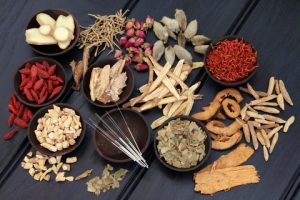A Brief history of Chinese herbal medicine
Applications of Chinese herbal Medicine
 A Brief history of Chinese herbal medicine
A Brief history of Chinese herbal medicine
Chinese herbal medicine as a science traces back a little over 2000 years ago to a book called ‘The Divine Husbandman’s Classic of the Material Medica’ (Shen Nong Ben Cao Jing) attributed to the legendary emperor Shen Nong. This book categorised 365 herbs into three groups: Tonic herbs suitable for long term use to promote health; herbs suitable for medium term use to address constitutional issues; and strong herbs which are suitable for short term cautious use only. An understanding of safe and toxic herbs was well developed at this time.
On this foundation later scholars explored the interaction of herbal medicines in the body and with each other to develop a rich understanding of the suitability of herbs based on the nature of the illness and the constitution of the individual. The famous physician Zhang Zhongjing wrote ‘Treatise on Febrile Disease Caused by Cold’ (Shang Han Lun) around 200 AD and demonstrated such a intricate understanding of health and illness, and such an acute analysis of the effects of herbal medicine that this book is relevant today and the formulas contained in it are still commonly used. Over the intervening 1800 years various scholars have further developed and refined Chinese herbal medicine. The combination of the results of modern research with this rich history is the foundation of our practice of Chinese herbal medicine in the clinic.
In Chinese herbal medicine herbs are rarely used alone, but are classically combined into formulae of about 8 to 12 herbs. These classical combinations of herbs are designed to balance the effects of the principle herbs, focus the effect to the targeted body system or tissue, and take account of the individual constitution.
Preparation of Herbs
Traditionally herbs were boiled up and drunk for acute conditions or ground into pills for long term use. Today modern processing allows for concentrated herbal extracts to be prepared in gra nulated form in commercial laboratories for convenience of taking as well as ensuring quality control. In the clinic we use Chinese herbs in concentrated pill and capsule form that comply with Australian Therapeutic Goods Administration (TGA) Good Manufacturing Practice (GMP). GMP means that the herbs have been tested for pesticides and impurities, that the species used is positively identified, and that the active ingredients are clearly listed on the label.
nulated form in commercial laboratories for convenience of taking as well as ensuring quality control. In the clinic we use Chinese herbs in concentrated pill and capsule form that comply with Australian Therapeutic Goods Administration (TGA) Good Manufacturing Practice (GMP). GMP means that the herbs have been tested for pesticides and impurities, that the species used is positively identified, and that the active ingredients are clearly listed on the label.
GMP is one way of combining the quality and consistency we expect from modern medicines while use traditional herbal ingredients.
Applications of Chinese herbal Medicine
Because Chinese herbal medicine is individualised a consultation will involve detailed questioning as well as incorporating information from palpation of the pulse and examination of the tongue. There is a saying in Chinese medicine ‘same disease different treatment, different disease same treatment’. This apparently paradoxical statement sums up that when prescribing Chinese herbal medicine it is the total picture of the symptoms and the persons individual constitutional characteristics which determines treatment, not just the symptoms or the name of the condition alone. It is this perspective which allows Chinese medicine to offer a unique insight into a persons health.
How to take your herbs
For information on how to take the herbs we use in the clinic download What You Need to Know about taking herbs and supplements safely from our client login area.

 A Brief history of Chinese herbal medicine
A Brief history of Chinese herbal medicine